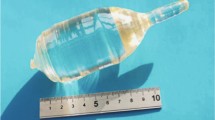Abstract
The advanced Mo-based rare process experiment (AMoRE) is an international project searching for the neutrinoless double beta (\(0\nu \beta \beta \)) decay of \(^{100}\)Mo using low-temperature calorimetric detection of heat and light signals based on magnetic microcalorimeter (MMC) readouts. \(\hbox {Li}_2\hbox {MoO}_4\) crystals have been considered as the main target crystals for the second phase of the AMoRE project, which aims to use 100 kg of \(^{100}\)Mo. However, the hygroscopicity of \(\hbox {Li}_2\hbox {MoO}_4\) requires moistureless processes during surface treatment, storage, detector assembly, and installation. \(\hbox {PbMoO}_4\) crystals are nonhygroscopic and exhibit high scintillation efficiency, often leading to high particle discrimination power in the phonon channel via pulse-shape analysis and light/heat ratio variation. A low-temperature detector setup with a 1 \(\hbox {cm}^3\) cubic crystal of \(\hbox {PbMoO}_4\) was prepared for simultaneous heat and light detection based on MMC readouts. After study of internal background control using archeological Pb, \(\hbox {PbMoO}_4\) crystal can be a promising candidate crystal. We present a feasibility study of \(\hbox {PbMoO}_4\) crystals for a \(0\nu \beta \beta \) experiment.




Similar content being viewed by others
Change history
07 October 2022
A Correction to this paper has been published: https://doi.org/10.1007/s10909-022-02869-8
References
J. Schechter, J.W.F. Valle, Phys. Rev. D 25, 2951–2954 (1982). https://doi.org/10.1103/PhysRevD.25.2951
C. Alduino et al., Eur. Phys. J. C 77, 13 (2017). https://doi.org/10.1140/epjc/s10052-016-4498-6
E. Armengaud et al., Phys. Rev. Lett. 126, 181802 (2021). https://doi.org/10.1103/PhysRevLett.126.181802
M. Agostini et al., Phys. Rev. Lett. 125, 252502 (2020). https://doi.org/10.1103/PhysRevLett.125.252502
A. Gando et al., Phys. Rev. Lett. 122, 192501 (2019). https://doi.org/10.1103/PhysRevLett.122.192501
V. Alenkov et al., Eur. Phys. J. C 79, 791 (2019). https://doi.org/10.1140/epjc/s10052-019-7279-1
J. Kotila, F. Iachello, Phys. Rev. C 85, 034316 (2012). https://doi.org/10.1103/PhysRevC.85.034316
V. Alenkov et al., “Technical design report for the amore \(0\nu \beta \beta \) decay search experiment,” (2015). arXiv:1512.05957
Y.H. Kim, S.J. Lee, B. Yang, Supercond. Sci. Technol. 35, 063001(2022). https://doi.org/10.1088/1361-6668/ac6a1c
H.J. Kim et al., Cryst. Res. Technol. 54, 1900079 (2019). https://doi.org/10.1002/crat.201900079
H.L. Kim et al., Nucl. Instr. Meth. A 954, 162107 (2020). https://doi.org/10.1016/j.nima.2019.04.061
S.G. Kim et al., IEEE Trans. Appl. Supercond. 31, 1–5 (2021). https://doi.org/10.1109/TASC.2021.3066179
S.Y. Oh et al., Supercond. Sci. Technol. 30, 084005 (2017). https://doi.org/10.1088/1361-6668/aa7431
L. Gironi, J. Low Temp. Phys. 167, 504–509 (2012).. https://doi.org/10.1007/s10909-012-0478-x
H.L. Kim et al., J. Low Temp. Phys. 199, 1082–1088 (2020). https://doi.org/10.1007/s10909-019-02291-7
V.N. Shlegel et al., J. Instrum. 12, C08011 (2017). https://doi.org/10.1088/1748-0221/12/08/c08011
L. Pattavina et al., Eur. Phys. J. A 55, 127 (2019). https://doi.org/10.1140/epja/i2019-12809-0
L. Pattavina et al., Eur. Phys. J. A 56, 38 (2020). https://doi.org/10.1140/epja/s10050-020-00050-x
A. Hedayat, A. Khounsary, F. Mashayek, Proc. SPIE 8502, 85020O (2012). https://doi.org/10.1117/12.929362
D. McCammon, Cryogenic particle detection (Springer, Berlin, 2005). https://doi.org/10.1007/10933596_1
Y.N. Yuryev et al., Nucl. Instr. Meth. A 635, 82–85 (2011). https://doi.org/10.1016/j.nima.2011.01.127
G.B. Kim, J. Low Temp. Phys. 199, 1004–1011 (2020). https://doi.org/10.1007/s10909-020-02365-x
V. Babin et al., Radiat. Meas. 38, 533–537 (2004). https://doi.org/10.1016/j.radmeas.2004.02.005
J.Y. Lee et al., J. Korean Phys. Soc. 71, 928–933 (2017). https://doi.org/10.3938/jkps.71.928
H.L. Kim et al., IEEE. T. Nucl. Sci. 65, 766–770 (2018). https://doi.org/10.1109/TNS.2017.2788898
Acknowledgements
This research is supported by the Institute for Basic Science (IBS) under project codes IBS-R016-D1 and IBS-R016-A2, and the Ministry of Science and Higher Education of the Russian Federation N121031700314-5.
Author information
Authors and Affiliations
Corresponding author
Additional information
Publisher's Note
Springer Nature remains neutral with regard to jurisdictional claims in published maps and institutional affiliations.
The original online version of this article was revised: In the figure 3 caption the following words were removed inadvertently "% rising and falling and 50% falling positions". However, the error in the figure 3 caption is corrected.
Rights and permissions
Springer Nature or its licensor holds exclusive rights to this article under a publishing agreement with the author(s) or other rightsholder(s); author self-archiving of the accepted manuscript version of this article is solely governed by the terms of such publishing agreement and applicable law.
About this article
Cite this article
Kim, H.L., So, J.H., Kim, Y.H. et al. A Study on \(\hbox {PbMoO}_4\) Phonon-Scintillation Detection with MMC Readouts for a Neutrinoless Double Beta Decay Search. J Low Temp Phys 209, 409–416 (2022). https://doi.org/10.1007/s10909-022-02824-7
Received:
Accepted:
Published:
Issue Date:
DOI: https://doi.org/10.1007/s10909-022-02824-7




